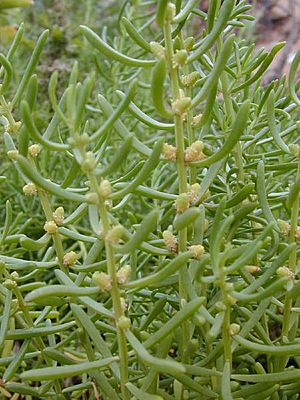Saltwort facts for kids
Quick facts for kids Saltwort |
|
|---|---|
 |
|
| Scientific classification | |
| Genus: |
Batis (plant)
|
| Species: |
maritima
|
| Synonyms | |
|
|
Batis maritima, also known as saltwort or beachwort, is a special type of plant. It's called a halophyte, which means it loves to grow in salty places! You might also hear it called turtleweed, pickleweed, or barilla.
This plant is a perennial, meaning it lives for many years. It's also a succulent, so its leaves are thick and juicy, like a cactus, to store water. Batis maritima plants are dioecious, which means there are separate male and female plants.
You can find this plant growing in dense groups in places like salt marshes, swamps, and near salty mud flats. It's a "pioneer plant" because it quickly grows and covers areas where storms, like hurricanes, have damaged the natural plants.
Even though it's not widely used for food yet, its seeds have a lot of healthy oil. This oil is packed with good nutrition!
Contents
What Saltwort Looks Like
These plants are like small shrubs, growing from about 0.1 to 1.5 meters (4 inches to 5 feet) tall. They form thick patches.
- Leaves: The leaves are juicy and grow in pairs directly opposite each other on the stem.
- Flowers: Saltwort has small, white flowers. They can't pollinate themselves. The pollen is carried by the wind from male plants to female plants.
- Seeds: The seeds are tiny, about 1.1 mm long and 0.8 mm wide. They are super light, weighing only about 0.5 milligrams each! They have a smooth, dark, and very hard coating. It's amazing, but these seeds can even float in seawater for months and still sprout later!
- Roots: The main root starts branching out early. It doesn't branch much until the plant grows taller than 10 cm (4 inches).
Where Saltwort Grows and What It Needs
Batis maritima grows along the tropical coasts of North and South America, as well as the Caribbean Islands. It doesn't usually grow too far north because it can't handle too much frost.
- Salty Homes: This plant often lives in places hit by strong tropical storms. It usually grows less than 1 meter (3 feet) above sea level. It loves areas where the water is salty, like muddy tidal banks, mangrove swamps, and salt marshes.
- Not Just Salt: While it loves salt, it can also grow in regular soil. However, in non-salty soil, other plants might outcompete it.
- Tough Plant: Saltwort is very strong and can grow well in many different environments. Insects, diseases, or animals eating it don't usually bother it much. But it doesn't like to be completely covered by sand.
In some places, like Hawaii, Batis maritima has become an invasive species. This means it grows so well that it can push out the plants that naturally belong there.
How People Use Saltwort
People have found many uses for this amazing plant!
- Leaves: In Puerto Rico, people sometimes add the leaves to salads. They can also be cooked like a vegetable, made into a puree, or pickled.
- Seeds: The seeds can be added to salads, toasted, or even "popped" like popcorn!
- Roots: Long ago, the Comcáac people used the roots to sweeten their coffee before they had sugar.
- Meal: The plant can produce a yellow or golden flour-like meal that is used for food. Because its seeds have so much oil, it could become an important plant for making oil.
- Traditional Medicine: In Puerto Rico, Batis maritima has been used in traditional medicine to help with things like gout, eczema, and other health issues.
Saltwort Seeds: What's Inside?
The seeds of Batis maritima are packed with good stuff!
| Content | Amount |
|---|---|
| Carbohydrates | 46.5 % |
| Fructose | 0.1 % |
| Glucose | 0.03 % |
| Sucrose | 1.20 % |
| Fat | 25 % |
| Protein | 17.3 % |
| Water | 7.3 % |
| Calcium | 1600 ppm |
| Iron | 259 ppm |
| Magnesium | 4200 ppm |
| Phosphorus | 8400 ppm |
| Potassium | 8500 ppm |
| Sodium | 500 ppm |
Carbohydrates are the main part of the seeds. The tiny size of their starch grains could be useful for different food and non-food products. They also have low amounts of sugar.
The seeds are a great source of protein. They also contain important amino acids like lysine and methionine, which are often missing in many cereal grains.
Saltwort seeds have a lot of oil, about 25%. This is similar to the oil content in plants like safflower and sunflower. The oil is very healthy, with a high amount of linoleic acid (73%). It's also rich in healthy compounds called tocopherols and phytosterols.
The seeds are full of important minerals like phosphorus, potassium, calcium, magnesium, and iron. Even though it grows in salty places, the seeds don't store a lot of sodium, which is good for nutrition.
How Saltwort Survives and Thrives
Batis maritima is known for being a major plant that grows back after mangrove forests are destroyed by hurricanes.
- Water Lover: Even though it's not a water plant, it can handle short floods and long periods where its roots are in waterlogged soil.
- Salt Management: Saltwort grows slowly in very salty soils, but it doesn't have much competition from other plants there. It deals with salt by storing it in special sacs in its cells called vacuoles. Eventually, it sheds these salty leaves.
- Helpful Fungi: Tiny fungi called mycorrhizae live on its roots. These fungi help the plant get water and nutrients like phosphate, making it even stronger.

